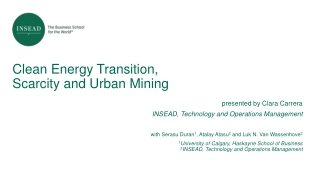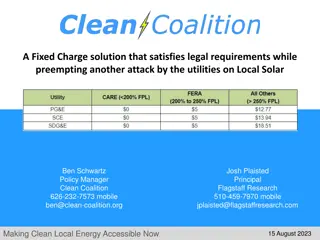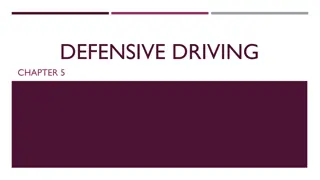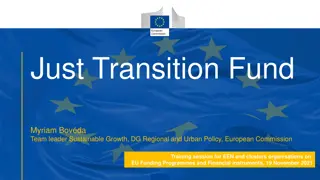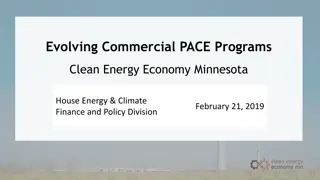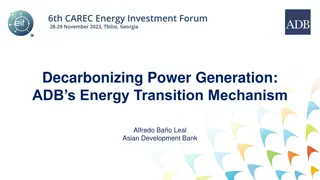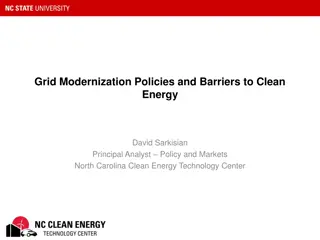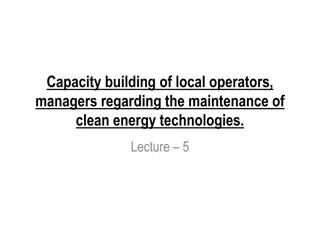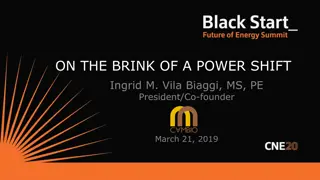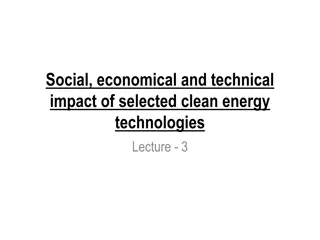Energy Communities: Driving Clean Energy Transition
Citizen-driven energy communities promote a clean energy shift by enhancing local energy efficiency. Members produce, consume, store, and sell energy, fostering environmental, economic, and social benefits. Learn about the characteristics, goals, categories, and generation models of energy communities, along with a case study on the Brooklyn Microgrid in NYC. Explore how these communities contribute to public deployment of distributed energy resources, attract private investment, increase renewable technology acceptance, and lower electricity bills.
Download Presentation

Please find below an Image/Link to download the presentation.
The content on the website is provided AS IS for your information and personal use only. It may not be sold, licensed, or shared on other websites without obtaining consent from the author.If you encounter any issues during the download, it is possible that the publisher has removed the file from their server.
You are allowed to download the files provided on this website for personal or commercial use, subject to the condition that they are used lawfully. All files are the property of their respective owners.
The content on the website is provided AS IS for your information and personal use only. It may not be sold, licensed, or shared on other websites without obtaining consent from the author.
E N D
Presentation Transcript
HHU Potential disruption of the insurance industry Presented by: Lukas Grote Ina Jonalik Johann Wiebold Lina Zaika Presenting to: Panel of Judges 1/8/2019 HHU
HHU Incremental innovations give potential room for disruption Disruption theory by Christensen (1997) Performance high middle low Time 1/8/2019 HHU 2
HHU Agenda 01 Industry assessment 02 Roots of disruption 03 Industry reaction 04 Strategic alternatives 1/8/2019 HHU 3
HHU Disruption developed to an overarching megatrend Industry Underlying trend Current state Example Asset Management Artificial Intelligence Early BlackRock Robo Advisor Energy Climate change Developed Coal exit in Germany Entertainment Cloud technology Developed Netflix Health Biotech Early Siemens Healthineers Hospitality Peer-to-Peer Developing Airbnb Mobility Autonomous driving Developing Google car Insurance Blockchain Early Teambrella Retail Online marketplaces Developed Amazon 1/8/2019 HHU 4
HHU The focus will lay on the industries which have the highest potential to react successfully Industry Underlying trend Current state Example Asset Management Artificial Intelligence Early BlackRock Robo Advisor Energy Climate change Developed Coal exit in Germany Entertainment Cloud technology Developed Netflix Health Biotech Early Siemens Healthineers Hospitality Peer-to-Peer Developing Airbnb Mobility Autonomous driving Developing Google car Insurance Blockchain Early Teambrella Retail Online marketplaces Developed Amazon Potential State of disruption Disruptor power 1/8/2019 HHU 5
HHU Many potentially disrupting trends are coming up in the insurance industry Industry Underlying trend Current state Example Asset Management Artificial Intelligence Early BlackRock Robo Advisor Energy Climate change Developed Coal exit in Germany Entertainment Cloud technology Developed Netflix Health Biotech Early Siemens Healthineers Hospitality Peer-to-Peer Developing Airbnb Mobility Autonomous driving Developing Google car Insurance Technology Early Teambrella (Blockchain) Retail Online marketplaces Developed Amazon Potential State of disruption Disruptor power 1/8/2019 HHU 6
HHU Factors at the root of potential disruption New Automation technologies Inflexible corporates Standardized products Digital insurer Underpenetrated markets 1/8/2019 HHU 7
HHU Disruption in the insurance industry Performance high middle low time 1/8/2019 HHU 8
HHU Current costumer journey $0 1/8/2019 HHU 9
HHU Blockchain-based P2P insurance costumer journey $300 1/8/2019 HHU 10
HHU Insurances have reacted to the disrupting trends rather slowly Applied technological trends in insurance industry Example Blockchain B3i (blockchain insurance industry initiative) Different use cases e.g. Axa flight insurance AI Automated claim management Internet of Things Smart products 1/8/2019 HHU 11
HHU Traditional insurance companies could be cut out of the industry Only incremental innovation New business models need to be taken into account 1/8/2019 HHU 12
HHU How could insurance companies react differently? Build up own resources Run Accelerator & Incubator programs Buy start-ups Business as usual Shift costumer focus Support start-ups, share knowledge to develop together and set base to act when the business is mature Focus on customer groups that are less likely to adapt Peer- to-Peer (e.g. business clients) Set up own portal for Peer-to-Peer organically insurances and monetarize it Use knowledge to build up new revenue stream right away Continue insurance business without changes and serve remaining customers 1/8/2019 HHU 13
HHU Different strategies have their pros and cons Build up own resources Run Accelerator & Incubator programs Buy start-ups Business as usual Shift costumer focus + no additional costs + more robustness to disruption + more influence + immediate integration of know-how + low risk + flexibility + close to new trends + mitigate risk of cannibalization - - High risk of disruption Loss of customers - Hard to build to internally costly Time intensive - Loss of private customers Lost potential - - Concept won t succeed High investment risk - - - - Difficulty to integrate 1/8/2019 HHU 14
HHU Different strategies have their pros and cons Build up own resources Run Accelerator & Incubator programs Buy start-ups Business as usual Shift costumer focus + no additional costs + more robustness to disruption + more influence + immediate integration of know-how + low risk + flexibility + close to new trends + mitigate risk of cannibalization - - High risk of disruption Loss of customers - Hard to build to internally costly Time intensive - Loss of private customers Lost potential - - Concept won t succeed High investment risk - - - - Difficulty to integrate 1/8/2019 HHU 15
HHU Insurance industry is facing potential disruption Act now! 1/8/2019 HHU 16
HHU Risks and mitigation I. Regulations might hinder the future business model Impact II. Development of blockchain technology might not be as promising as expected I. II. Probability 1/8/2019 HHU 17



